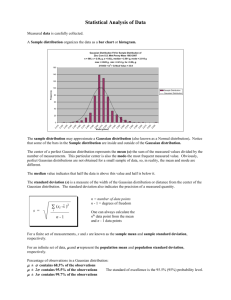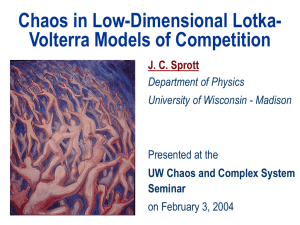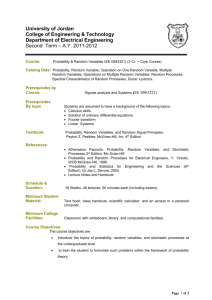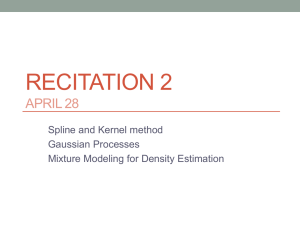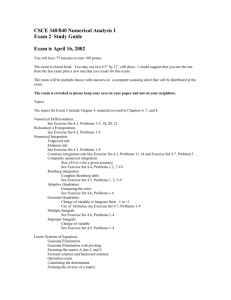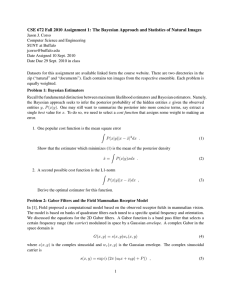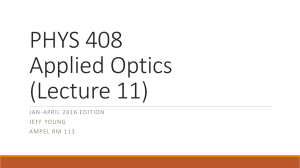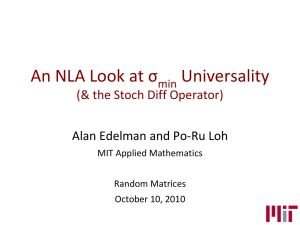darwin - University of Wisconsin
advertisement
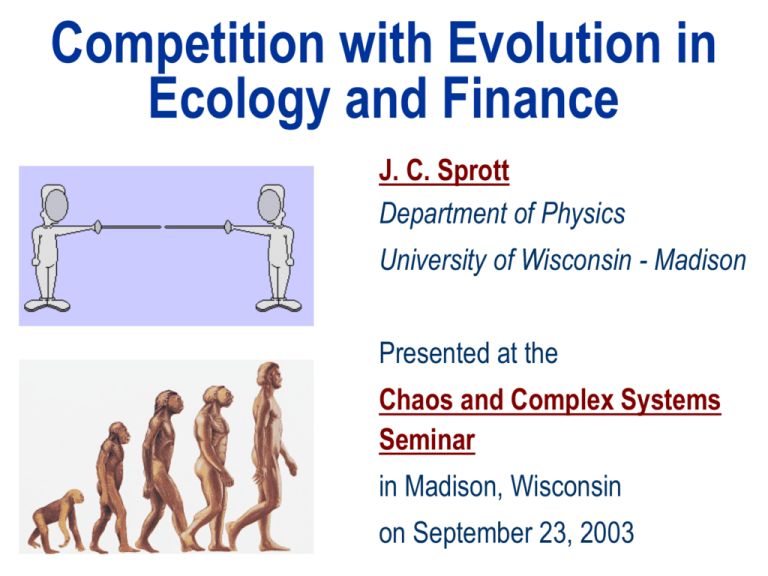
Competition with Evolution in Ecology and Finance J. C. Sprott Department of Physics University of Wisconsin - Madison Presented at the Chaos and Complex Systems Seminar in Madison, Wisconsin on September 23, 2003 Mathematics To the outsider, mathematics is a strange, abstract world of horrendous technicality, full of symbols and complicated procedures, an impenetrable language and a black art. To the scientist, mathematics is the guarantor of precision and objectivity. It is also, astonishingly, the language of nature itself. No one who is closed off from mathematics can ever grasp the full significance of the natural order that is woven so deeply into the fabric of physical reality. -- Paul Davies (Australian astrobiologist) Rabbit Dynamics Let R = # of rabbits dR/dt = bR - dR = rR Birth rate Death rate r=b-d •r>0 growth •r=0 equilibrium •r<0 extinction Multispecies Lotka-Volterra Model • Let Si be population of the ith species (rabbits, trees, people, viruses, …) N • dSi / dt = riSi (1 - Σ aijSj ) j=1 • Parameters of the model: • Vector of growth rates ri • Matrix of interactions aij • Number of species N Parameters of the Model Growth rates r1 r2 r3 r4 r5 r6 Interaction matrix 1 a21 a31 a41 a51 a61 a12 1 a32 a42 a52 a62 a13 a23 1 a43 a53 a63 a14 a24 a34 1 a54 a64 a15 a25 a35 a45 1 a65 a16 a26 a36 a46 a56 1 Choose ri and aij randomly from an exponential distribution: 1 P(x) = e-x P(x) x = -LOG(RND) mean = 1 0 0 x 5 Typical Time History 15 species Si Time Coexistence Coexistence is unlikely unless the species compete only weakly with one another. Species may segregate spatially. Diversity in nature may result from having so many species from which to choose. There may be coexisting “niches” into which organisms evolve. Typical Time History (with Evolution) 15 species 15 species Si Time Evolution of Total Biomass Biomass 32 species Time Evolution of Biodiversity Biodiversity (%) 32 species Time Conclusions Competitive exclusion eliminates most species. The dominant species is eventually killed and replaced by another. Species that grow quickly also die quickly. Evolution is punctuated rather than continual. Application to Finance S&P500 Gaussian Model Volatility S&P500 Gaussian Model Digression – The Bell Curve Aka: Normal distribution or Gaussian distribution P(x) = e -x2/2 "Everybody believes in the exponential law of errors: the experimenters, because they think it can be proved by mathematics; and the mathematicians, because they believe it has been established by observation." (Whittaker and Robinson, 1967) What have mathematicians proved? The Gaussian distribution is special because of the Central Limit Theorem. Imagine the following experiment: 1. Create a population with a known distribution (which does not have to be Gaussian). 2. Randomly pick many samples from that population, and calculate the means of these samples. 3. Draw a histogram of the distribution of the means. The central limit theorem says that with enough samples, the distribution of means will follow a Gaussian distribution even if the population is not Gaussian. Hence, any set of measurements of a given quantity will be distributed about the mean in a Gaussian distribution if the measurements are statistically independent. N=1 N=2 N=4 N = 100 N=1 N=2 N=4 N=8 Mean First moment <xP(x)> -1 0 Variance 1 Second moment <x2P(x)> 0.5 1 2 Skewness Third moment <x3P(x)> 0.5 0 -0.5 Fourth moment <x4P(x)> − 3 Kurtosis 0 3/2 (leptokurtic) -2/3 (platykurtic) Kurtosis of Various Time Series Time Series EKG (2000 heartbeat intervals) Physics 103 final exam Light from variable white dwarf star Deterministic CA forest model Stochastic CA forest model Daily temperature change (1980-1989) EEG (8 seconds) Daily S&P500 change (1975-1987) Plasma magnetic fluctuations Eye movement data (Aks) Pound/$ daily exchange rate (1971-2003) Yen/$ daily exchange rate (1973-2003) DM/$ daily exchange rate (1973-1987) Competition model with evolution Kurtosis -0.43 -0.26 -0.24 -0.07 0 0.57 0.61 2.13 3.19 3.96 4.35 4.77 6.51 ??? 2.86 EVENT SIZE Is the Model SOC? RANK Zipf’s law of language Current model Scale invariance also observed in city populations, earthquake sizes, stock prices, Internet connectivity, Web links, Moon craters, asteroid sizes, … Is the Model Chaotic? Total Biomass versus time 1% perturbation to one of 15 species added here Summary Nature is complex but Simple models may suffice References http://sprott.physics.wisc.edu/lectures/ darwin.ppt (This talk) sprott@physics.wisc.edu
